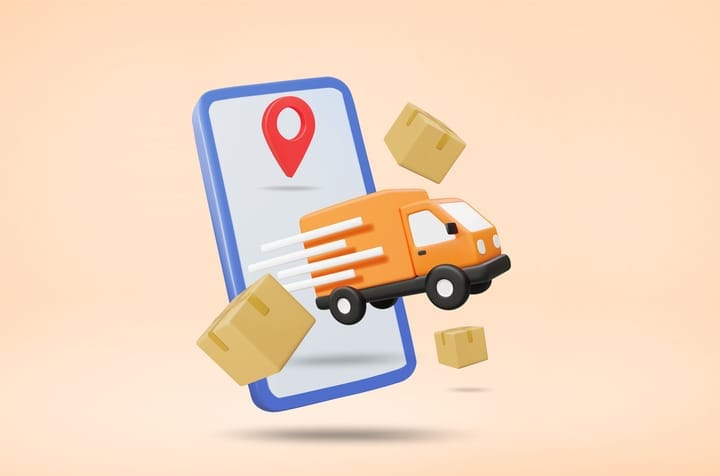How to Handle Customer Returns in e-Commerce
Learn how to handle customer returns, balancing business logic with customer satisfaction.

Returns are not a favorite topic for sellers. It’s often a euphemism that masks the reality: the buyer didn’t like the product and doesn’t want to keep it, for any number of reasons.
Apart from the customer being unhappy, this means the investment in acquiring the customer and fulfilling the order has gone to waste. A returned product requires additional marketing efforts to resell and recoup the lost profit.
This is why many sellers aim to minimize returns. Some even complicate the returns process, hoping shoppers will decide the hassle isn’t worth it and keep the product instead.
If complicating the return process isn’t your preferred approach to return management, this article is for you. We’ll explore the topic in depth, offering practical strategies to minimize returns and ensure a smooth, hassle-free process for e-commerce sellers when those do happen.
What is Returns Management?
Returns (return) management refers to a set of strategies and procedures that sellers implement to reduce the negative impact of product returns on their bottom line. Effective returns management involves several key aspects, including:
- Reducing the likelihood of returns before purchase: This can be achieved through clear and detailed size guides, accurate product descriptions, and high-quality images to set the right expectations for customers.
- Streamlining the return workflow: Ensuring that the process is efficient and easy for employees to handle, minimizing disruptions to other business operations.
- Simplifying the return process for customers: Making returns hassle-free creates a positive experience for customers and increases the likelihood they will shop again even though this time, they decided to return the product.
- Preventing fraudulent returns: Utilizing data analytics and other tools to identify and reduce returns from “serial returners” or those exploiting return policies.
Preventing Returns Before a Purchase
Here are some ways to prevent future returns for e-commerce sellers before the customer makes a purchase.
Detailed Product Descriptions
Enhancing product descriptions is a powerful tool for preventing returns by setting realistic expectations for customers. Some of the ways to help shoppers visualize the product and assess its suitability for their needs include:
- High-resolution photos
- Videos that demonstrate usage scenarios
- Infographics showcasing features of the product
- Detailed size guides
Virtual Try-ons
Virtual try-on technology lets customers visualize how a product will look or fit before making a purchase. Using augmented reality (AR) or 3D modeling, virtual try-ons simulate the experience of interacting with the product.
Virtual try-ons for apparel, eyewear, or make-up products let customers see how items will fit their body or face using their device's camera.
Similarly, home decor brands offer AR tools that allow users to place furniture virtually in their living spaces to check size, color, and style compatibility.
These tools function by leveraging visual recognition technologies. Customers upload a photo, use a live camera feed, or input key measurements, and the system overlays the product on the image or video feed in real-time.
Offline Try-ons
Offline try-on options for goods sold online are an effective way to bridge the gap between e-commerce and the tactile shopping experience. By offering customers the ability to see, feel, and test products in person before making a purchase, businesses can significantly reduce the likelihood of returns and build greater trust in their brand.
This approach often takes the form of partnerships with physical stores, pop-up shops, or dedicated try-on hubs where customers can interact with the products they discovered online.
A prime example of the value offline try-ons bring is found in IKEA stores. At IKEA, customers can fully engage with the products—touching, trying out, smelling, and even turning items on and off. You can even lay on mattresses to ensure you find the perfect fit for your needs. This hands-on experience transforms shopping into a more personal and informed process—but also eventually minimizes returns!
Combining online purchases with offline try-ons is a popular purchasing pattern with Gen-Z buyers who value the integration of physical and virtual experience when shopping. Imagine how effective the convenience of online shopping can be with the reassurance of a hands-on experience.
Personalization to Minimize Product Returns
By leveraging data from a customer’s past purchases, browsing history, and preferences, online stores can tailor the shopping experience to guide customers toward better decisions:
- Based on previous purchases, stores can suggest products that align with the customer’s style, size, or needs.
- Data from prior orders or user-provided measurements can help flag potential size mismatches. For example, if a customer typically orders a size medium, the system can highlight that a selected item may run large or small based on other customers’ feedback. Similarly, a customer with a history of purchasing eco-friendly items should not see clothes made of real leather or fur in their feed.
Restocking of Returned Items
Returned items often require inspection, sorting, and categorization before they can be restocked, refurbished, or disposed of.
Create a return record by clicking the “Add Return” button and entering the sales order number of the initial purchase.
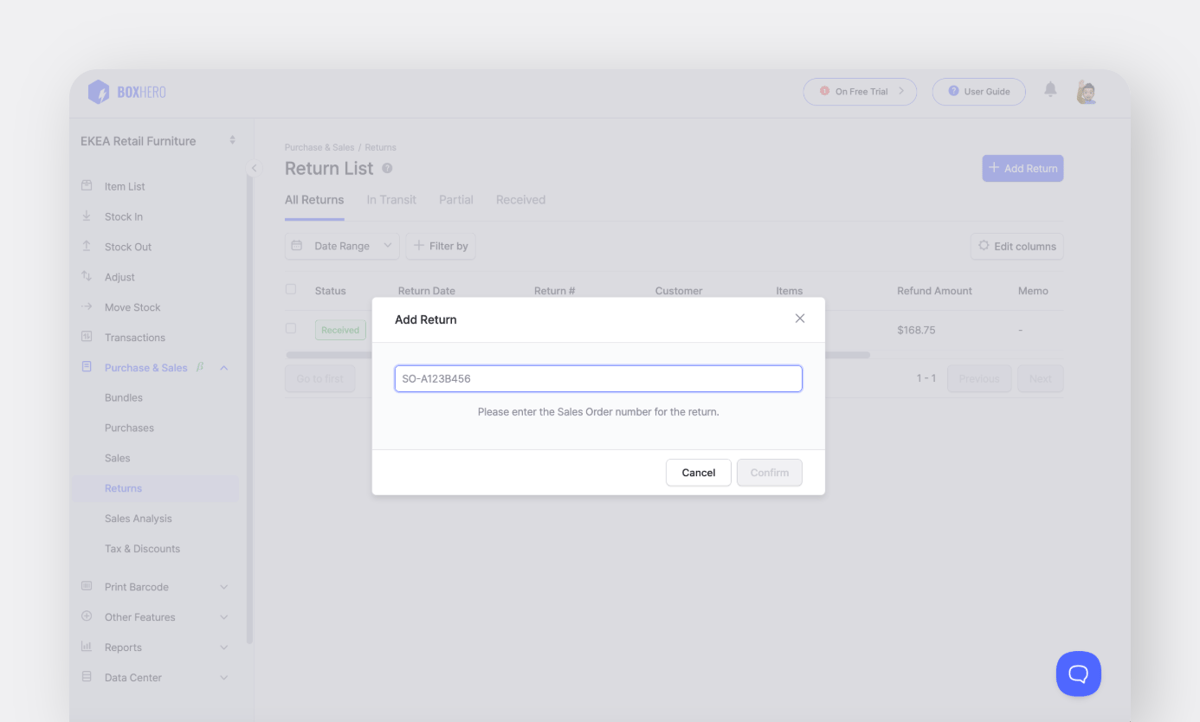
You can also create a return record right from the sales order in question.
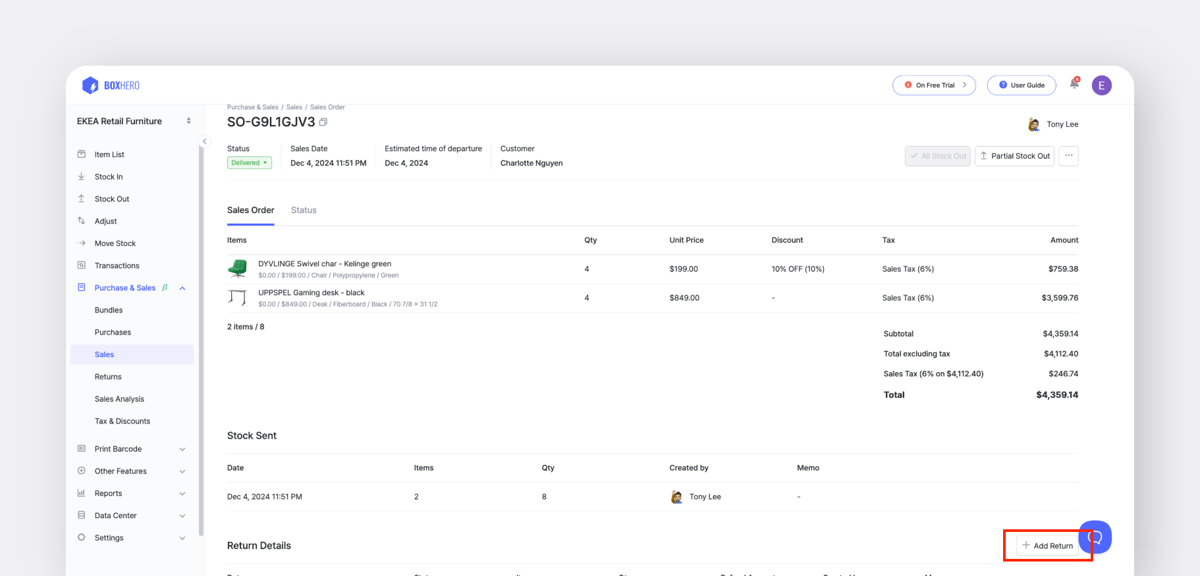
Select the items from the sales order that you want to return (1), the item quantity (2), and add a memo with additional information about the return.
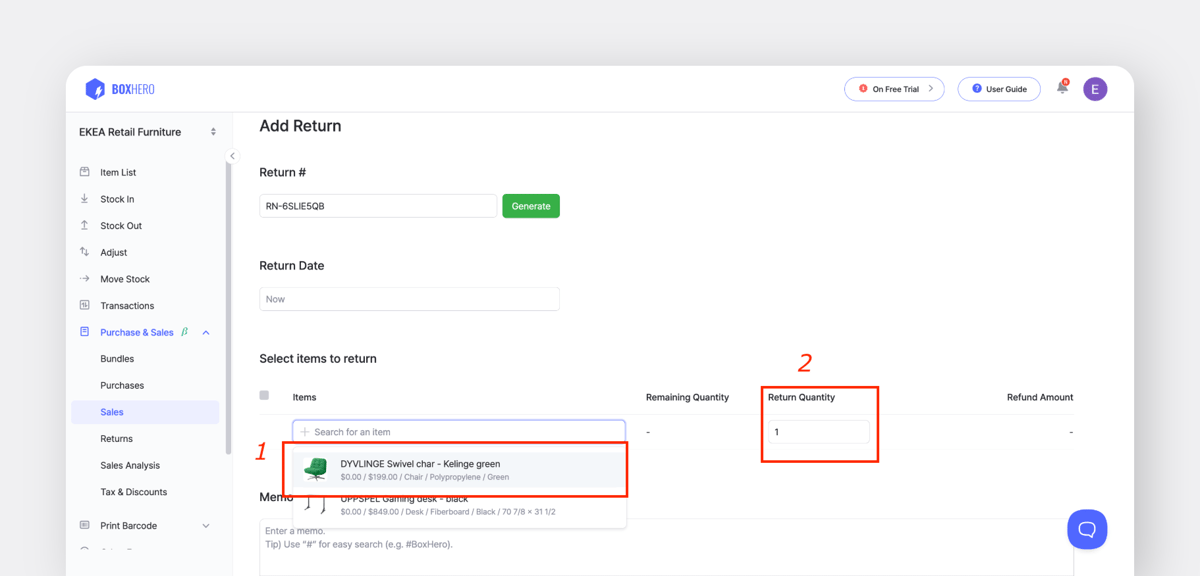
Once you receive the returned item, change the status of the return record to “received,” and the items will be in stock again.
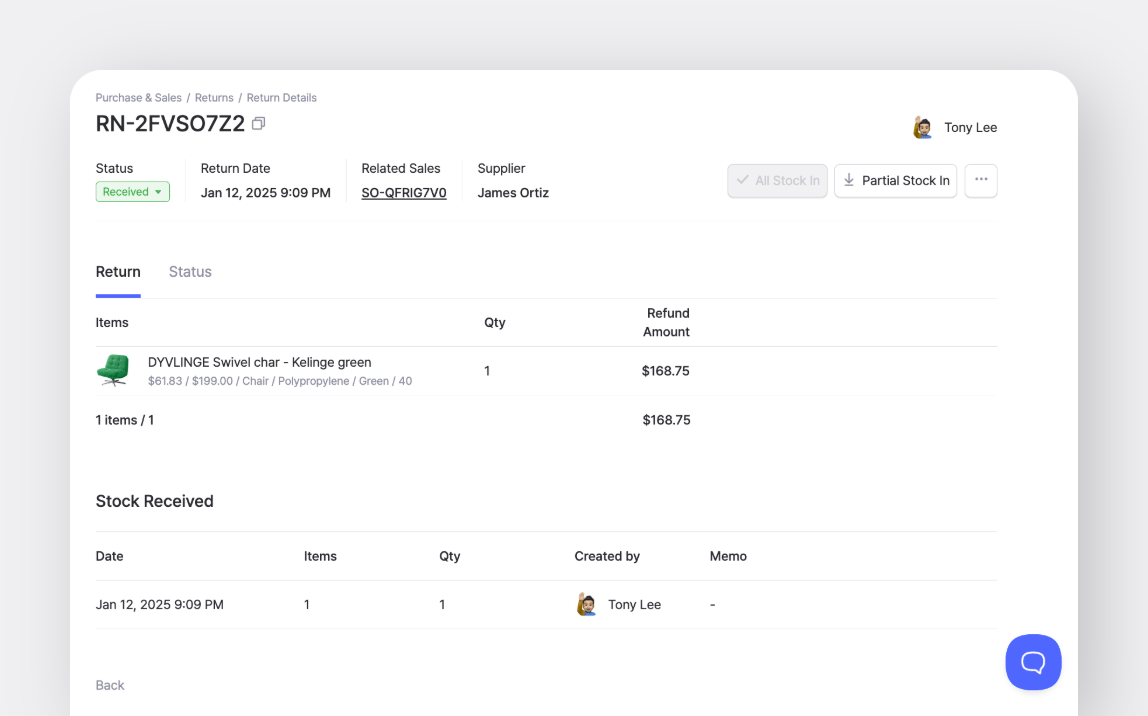
With BoxHero, you can track returns and how they influence your inventory, swiftly retrieving the returned items back to the warehouse and making them available for sale again.
Creating an Optimal Customer Experience During and After the Return
A prerequisite to creating a smooth return experience and ultimately retaining the customer for future purchases is a clear return policy.
Things to consider when drafting a return policy:
- Make the policy easy to access, read, navigate, and as short as possible.
Example: Before explaining the refund rules for different ticket types, Delta Airlines makes a disclaimer by describing the overall principles behind their return policy. A huge part of their clients (those traveling from the U.S. and Canada) might stop reading right there, having found the right information.
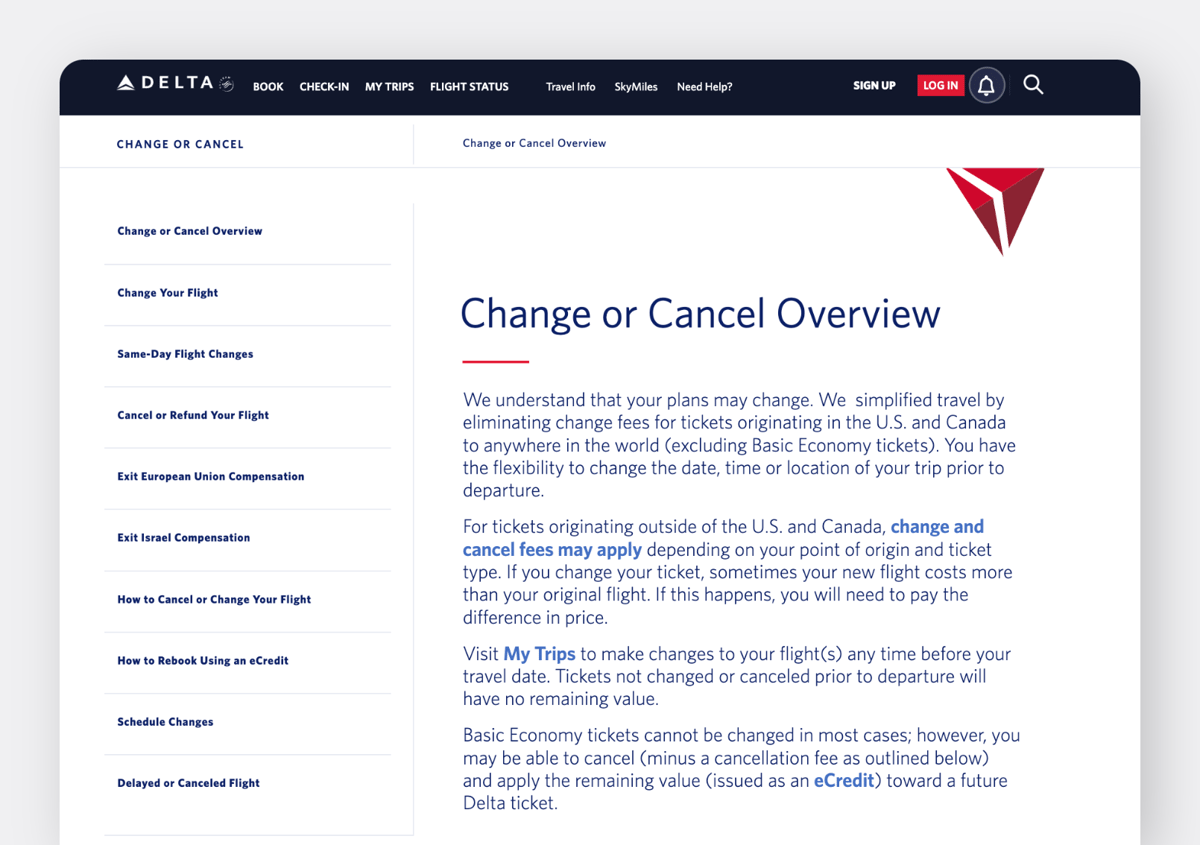
- Make shipping the items back as easy as possible.
Determine who is responsible for paying for shipping and handling fees associated with returns. Consider whether you will provide customers with pre-paid return labels, or require them to pay for shipping themselves.
- Remember that by simplifying the returns, you invest into customer relationships and possible future purchases.
If a customer is returning a product, they’re already dissatisfied. Don’t risk escalating the situation further by making the return process unnecessarily complicated.
Different Refund Options: Pros and Cons
When managing customer returns, businesses can offer various refund options, each with distinct advantages and drawbacks for both the company and the customer.
Option 1: Cash Refunds
A cash refund is when the customer receives their money back through their original payment method or as physical cash.
👍 Pros:
- Provides immediate resolution for the customer, enhancing satisfaction and trust.
- Aligns with customer expectations for a straightforward return policy.
👎 Cons:
- Means direct financial loss for the business.
- Involves high administrative costs, particularly for processing payment reversals.
- Offers no opportunity to retain the customer for future sales.
Option 2: Store Credits
Store credit is a refund alternative where the customer receives a non-cash voucher or account balance to use for future purchases at the store.
👍Pros:
- Encourages the customer to make another purchase, keeping the revenue within the business.
- Limits immediate cash outflows, which can be beneficial for cash flow management.
👎 Cons:
- May feel restrictive or less favorable to customers compared to cash refunds.
- Requires businesses to manage additional tracking systems for issued credits.

Option 3: Product Exchange
A product exchange allows customers to return an item and receive a replacement product of equal or similar value.
Pros:
- Means retaining the customer’s purchase within the business.
- Reduces the financial impact compared to issuing a cash refund.
👎 Cons:
- Involves additional inventory and logistical challenges for managing exchanges.
- May not fully satisfy the customer if the replacement product doesn’t meet expectations.
Option 4: Refund and Keep Policy
A refund and keep policy enables customers to receive a refund while keeping the original product. This approach is often used for low-cost or bulky items where return shipping costs exceed the product’s value.
👍 Pros:
- Reduces return shipping and restocking costs for the business.
- Enhances customer goodwill and satisfaction with minimal effort.
👎 Cons:
- May lead to increased financial loss.
- Risks potential abuse by customers expecting refunds without valid reasons.
Option 5: Loyalty Points
A variation of store credit, loyalty points can be awarded to the customer as part of a rewards program, offering future discounts or benefits tied to subsequent purchases.
👍 Pros:
- Fosters a stronger connection between the customer and the brand.
- Provides upselling opportunity because customers redeeming points often spend more than the value of the points.
👎 Cons:
- As with the others refund options redeemable directly and only through future purchases, might not provide the immediate satisfaction some customers seek.
- Can add operational complexity for maintaining.
Outsourcing Returns to 3PL Partners for Efficiency
Efficient reverse logistics is a top priority for third-party logistics businesses. They set up dedicated return centers and leverage advanced technology to optimize the returns process.
For example, they may use AI to predict which items will be returned, or introduce a smarter labeling system to speed up the restocking process.
Modern Return Management Tech
Some companies, such as Loop Returns, focus on simplifying return management for merchants. By combining technical expertise with thoughtful user experience design, Loop delivers a seamless return process for both merchants and their customers.
One of Loop’s standout features is its focus on alternatives to traditional returns. The platform empowers merchants to offer exchanges or store credits as alternatives to a straightforward return, right within the usual return workflow.


Loop integrates return alternatives into the return workflow so that the seller keeps the customer.
This approach not only minimizes financial losses but also fosters deeper engagement between brands and customers.
Moreover, Loop enables merchants to offer a "return guarantee" for shoppers for a small fee paid by the shopper.
Loop also provides other solutions for merchants, such as return fraud prevention through analytics. You might want to research what Loop offers to enhance the user journey of your shoppers, and prevent returns.
Collecting Data on Returns for Future Analysis
Merchants shouldn’t fear returns. Each return tells a story, offering valuable insights into product quality, sizing issues, or packaging.
For instance, consistent feedback about sizing discrepancies might prompt a brand to refine its size charts or provide clearer product descriptions. If returns frequently cite damage during transit, businesses can upgrade their packaging materials to ensure products arrive in better condition.
When shoppers see tangible improvements based on their feedback, they feel heard and valued. By researching return data, businesses can refine their offerings, improve operational efficiency, and deliver a seamless, customer-first shopping experience.
BoxHero for Return Management
One way to keep track of your returns is through inventory management solutions like BoxHero.
- BoxHero lets you register returns from an inventory management point of view, choosing the items from the previous sales that were returned, and stocking them in again.
- BoxHero offers real-time tracking across multiple warehouses, enhancing visibility into your return process if the item goes through more than one location on its journey back to you.
- BoxHero stores data on your stock-in and stock-out transactions, including returns, which you can further analyze and use in other software.
- BoxHero's Partners feature centralizes supplier and customer details, integrating partner interactions directly with inventory management workflows. Maintaining accurate records on everyone you communicate with allows you to strengthen business relationships. It's like a small-scale CRM right within your usual inventory management platform, with records on every person or company you speak to on a daily.
Conclusion
Managing customer returns is inherently complex, and many businesses struggle with the associated financial and logistical challenges. A well-thought-out return policy can transform these challenges into opportunities, ensuring smooth operations, reduced financial losses, and better cash flow.
Creating an effective return policy requires careful consideration of multiple factors. From the initial stages of preventing returns—such as detailed product descriptions, virtual try-ons, and personalized recommendations—to managing the return process itself with clear policies and efficient workflows.
Decisions about refund options, such as cash refunds, store credits, exchanges, or loyalty points, should align with both your business goals and customer expectations.
It’s also essential to leverage technology and data insights to improve your processes over time. Solutions like inventory management systems, reverse logistics platforms, and return analytics tools can help you identify patterns to address recurring issues.
Returns are a reflection of how your business values and serves its customers. By creating a thoughtful, customer-centric return policy, you can turn potential losses into long-term opportunities for growth, satisfaction, and loyalty.


